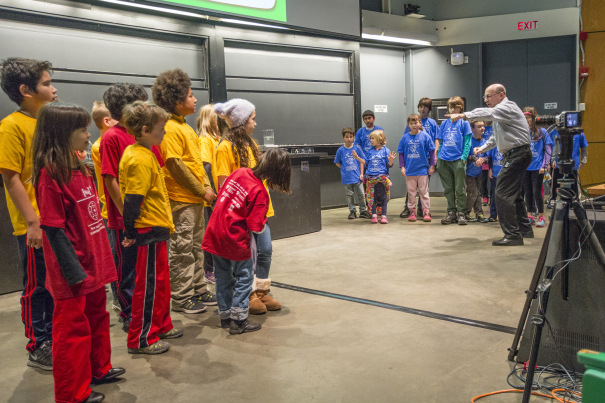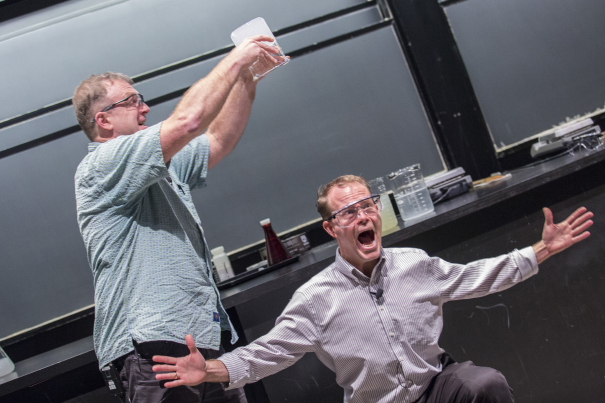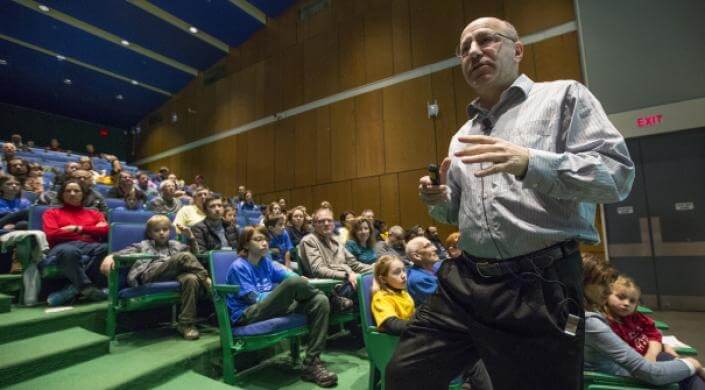News
Professor Howard Stone taught children and adults about the chemical properties of salt during the annual SEAS Holiday Lecture on Dec. 5
A pinch of salt is an ingredient in traditional holiday treats, from crispy potato latkes to spicy gingerbread cookies. Hundreds of children and adults learned this past weekend why salt is critical to not only their favorite food recipes, but to everyday life.
The chemical properties of salt was the focus of the 14th annual Holiday Lecture at the Harvard John A. Paulson School of Engineering and Applied Sciences on Dec. 5.
The interactive lecture, presented by Howard Stone, a former member of the Harvard faculty and now Dixon Professor in Mechanical and Aerospace Engineering at Princeton University, incorporated hands-on activities to showcase the marvels of chemistry.
“Our goal today is to convince you that the world is an amazing place, full of really wonderful and interesting things,” Stone said to kick off the presentation.
He began by explaining that table salt is comprised of positively-charged sodium ions and negatively-charged chlorine ions that bond to form crystals. Those salt crystals can dissolve in water because the positive part of water molecules (the oxygen ion) attracts the negative chlorine ions and the negative part of water molecules (the hydrogen ion) attracts the positive sodium ions. Rather than simply explain the process, Stone invited kids from the audience to act out the chemical reaction. Children wearing blue t-shirts, to represent water, “bonded” to their peers wearing red shirts (sodium) or yellow shirts (chlorine).

Professor Howard Stone directs children in an interactive demonstration of water dissolving a salt crystal. (Photo by Eliza Grinnell).
“That’s dissolution of a crystal by water!” Stone announced, as he directed groups of children around the front of the auditorium.
The audience burst into applause as the colorful “ions” returned to their seats. It was one of several interactive demonstrations that illustrated the science behind chemical processes. Stone used another demonstration to explain how chemistry and salt play a vital role in public health.
The audience watched intently as silver nitrate was added to saltwater, producing a milky precipitate. Stone then told the story of John Snow, a scientist living in London during the mid-1800s. Cholera outbreaks were common at that time, and many blamed poor air quality. Snow thought contamination in the Thames River was to blame, since much of London’s water supply came from the slightly salty river. To test his hypothesis, he collected water samples from homes of those who had fallen ill and added sodium nitrate to each. Ninety-percent of the samples turned white, proving that river water was the common factor in nearly all affected households.
“That was the first time water quality was linked to public health,” Stone said. “It changed public health history all over the world.”

Daniel Rosenberg (left) and Daniel Davis demonstrate what happens when you add sodium polyacrylate to water. (Photo by Eliza Grinnell).
Additional demonstrations showed how salt enables disposable diapers to absorb liquid and also highlighted the substance’s conductivity. Flashes of red and blue light illuminated the auditorium as children used drops of saltwater to conduct current flowing to small LEDs.
Kathy Sanders, of Arlington, helped her 9-year-old son, Max Sanders-Salerno, add saltwater to make his bulb shine brighter. She said she was glad her son was able to learn about ions in such an engaging way. “We’re hoping this exposure to science makes it more familiar and comfortable for him when he learns about it in school,” she said.
As families filed out of the auditorium after the lecture, Armaan Vasowalla, 14, of Andover, brought his parents to the front to get a closer look at the different chemicals. “I was surprised by the reaction time – the chemical reactions happened almost instantly,” he said.
For 12-year-old Jade Buckwalter, of Cambridge, the biggest surprise was the important role salt plays in so many common household products. “I learned that salt is a lot more important than people think,” she said.
The Holiday Lecture, jointly presented by SEAS and the Princeton University School of Engineering and Applied Sciences, was sponsored by the Materials Research Science and Engineering Center (MRSEC) at Harvard, the Princeton Center for Complex Materials, the Princeton University MRSEC, and the Princeton Institute for the Science and Technology of Materials.
Grains of truth
Six percent of the salt used annually in the U.S. is used for food.
Seventeen percent of the salt used annually in the U.S. is used for de-icing roads.
Most of the salt used for de-icing Boston’s roads is mined in the Atacama Desert in Chile.
Boston uses an average of 80,000 tons of road salt each year; last year the city used 110,000 tons.
The USDA recommends that one should consume no more than 2.4 grams (about a teaspoon) of sodium per day.
British chemist Humphry Davy discovered sodium and potassium in 1807.
Table salt commonly contains iodine, which was first added in the 1920s at the request of the U.S. government, since many people were not getting enough iodine in their diets naturally. Iodine deficiency can cause hypothyroidism.
Iron causes Himalayan salt to have a pink color.
About 200 million tons of salt is produced worldwide annually. The four top producers are China, the U.S., India, and Germany.
A Grain of Salt: Isn't It Ionic?
During the SEAS Holiday Lecture on Dec. 5, Daniel Rosenberg and Daniel Davis demonstrate what happens when you add sodium polyacrylate to water.
Cutting-edge science delivered direct to your inbox.
Join the Harvard SEAS mailing list.
Press Contact
Adam Zewe | 617-496-5878 | azewe@seas.harvard.edu
